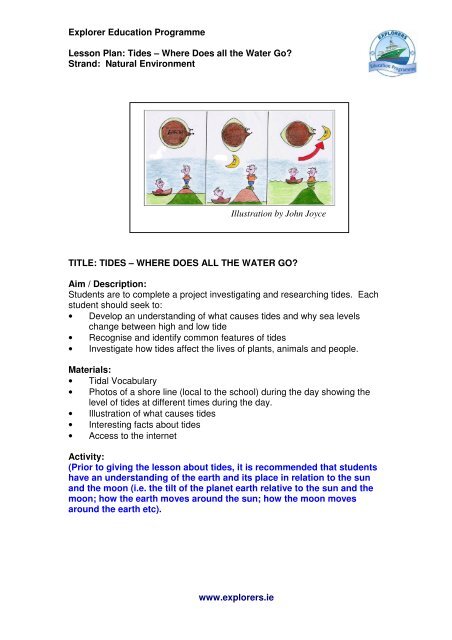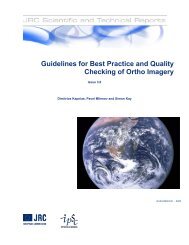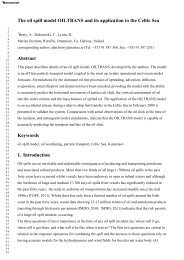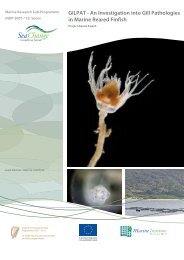Tides â Where Does all the Water Go?
Tides â Where Does all the Water Go?
Tides â Where Does all the Water Go?
Create successful ePaper yourself
Turn your PDF publications into a flip-book with our unique Google optimized e-Paper software.
Explorer Education ProgrammeLesson Plan: <strong>Tides</strong> – <strong>Where</strong> <strong>Does</strong> <strong>all</strong> <strong>the</strong> <strong>Water</strong> <strong>Go</strong>?Strand: Natural EnvironmentIllustration by John JoyceTITLE: TIDES – WHERE DOES ALL THE WATER GO?Aim / Description:Students are to complete a project investigating and researching tides. Eachstudent should seek to:• Develop an understanding of what causes tides and why sea levelschange between high and low tide• Recognise and identify common features of tides• Investigate how tides affect <strong>the</strong> lives of plants, animals and people.Materials:• Tidal Vocabulary• Photos of a shore line (local to <strong>the</strong> school) during <strong>the</strong> day showing <strong>the</strong>level of tides at different times during <strong>the</strong> day.• Illustration of what causes tides• Interesting facts about tides• Access to <strong>the</strong> internetActivity:(Prior to giving <strong>the</strong> lesson about tides, it is recommended that studentshave an understanding of <strong>the</strong> earth and its place in relation to <strong>the</strong> sunand <strong>the</strong> moon (i.e. <strong>the</strong> tilt of <strong>the</strong> planet earth relative to <strong>the</strong> sun and <strong>the</strong>moon; how <strong>the</strong> earth moves around <strong>the</strong> sun; how <strong>the</strong> moon movesaround <strong>the</strong> earth etc).www.explorers.ie
Explorer Education ProgrammeLesson Plan: <strong>Tides</strong> – <strong>Where</strong> <strong>Does</strong> <strong>all</strong> <strong>the</strong> <strong>Water</strong> <strong>Go</strong>?Strand: Natural EnvironmentVOCABULARY:Step1. <strong>Go</strong> through <strong>the</strong> tidal vocabulary and define <strong>the</strong> following words:• <strong>Tides</strong>: are <strong>the</strong> rise and f<strong>all</strong> of <strong>the</strong> surface of <strong>the</strong> ocean that occursapproximately every twelve and a half hours. This is due to <strong>the</strong>gravitational pull of <strong>the</strong> moon and <strong>the</strong> sun on <strong>the</strong> water mass of <strong>the</strong> sea.• High tide: is <strong>the</strong> highest point to which water rises on <strong>the</strong> seashore ateach tide. At any one time, high tides occur simultaneously on <strong>the</strong> sideof <strong>the</strong> Earth when it is directly below <strong>the</strong> moon, and again on <strong>the</strong>opposite side of <strong>the</strong> Earth.• Low tide: is <strong>the</strong> lowest point to which water descends on <strong>the</strong> seashoreat each tide. At any one time, low tides will occur when <strong>the</strong> Earth is notdirectly beneath <strong>the</strong> Moon, nor on <strong>the</strong> opposite side of <strong>the</strong> globe from <strong>the</strong>Moon.• Neap tides: are <strong>the</strong> weakest tides (i.e. with relatively low “High <strong>Tides</strong>”and relatively high “Low <strong>Tides</strong>”). They occur when <strong>the</strong> moon and <strong>the</strong> sunare at right angles with <strong>the</strong> Earth and are weak because <strong>the</strong> gravitationalforce of <strong>the</strong> sun and <strong>the</strong> moon cancel each o<strong>the</strong>r out.• Spring tides: are <strong>the</strong> highest and lowest tides of <strong>the</strong> month. Springtides occur when <strong>the</strong> moon and <strong>the</strong> sun are lined up with <strong>the</strong> Earth, sothat <strong>the</strong>ir gravitational forces combine, causing <strong>the</strong> strongest pull on <strong>the</strong>Earth and <strong>the</strong> waters that cover it.www.explorers.ie
Explorer Education ProgrammeLesson Plan: <strong>Tides</strong> – <strong>Where</strong> <strong>Does</strong> <strong>all</strong> <strong>the</strong> <strong>Water</strong> <strong>Go</strong>?Strand: Natural EnvironmentRESEARCH / INVESTIGATION:Step 2. Students (or <strong>the</strong> teacher) should identify a tidal area and if possibletake photos or complete drawings of <strong>the</strong> location showing <strong>the</strong>different levels of tides during <strong>the</strong> day.A). Ask <strong>the</strong> students to identify <strong>the</strong> features of <strong>the</strong> tide (where are <strong>the</strong> high andlow tide marks; where are <strong>the</strong> high and low tide marks during neap tides;where are <strong>the</strong> high and low tide marks during spring tides; how often does <strong>the</strong>tide come in and out over 24 hours. (Also, refer to lesson plan: Tidal Treatsand Retreats for activities learning about tides).B). Identify how animals and humans can be affected by <strong>the</strong> tides. (e.g. howanimals and plants on <strong>the</strong> shoreline are affected by exposure to sunshine andwind as <strong>the</strong> tides goes in and out and how <strong>the</strong> types of predators changefrom birds and land animals to fish, crabs and o<strong>the</strong>r marine predators; how<strong>the</strong> movement of boats in a harbour may be affected by <strong>the</strong> different waterlevels at high and low tides; how people fishing will be affected as <strong>the</strong> waterlevels change etc.).Step 3. As part of <strong>the</strong> research project, students should answer <strong>the</strong> questionsbelow and develop drawings to demonstrate <strong>the</strong>ir understanding.• What causes tides?<strong>Tides</strong> are caused by <strong>the</strong> gravitational pull of <strong>the</strong> sun and <strong>the</strong> moon on <strong>the</strong>Earth. The pull causes <strong>the</strong> ocean that surrounds <strong>the</strong> Earth to bulge or liftin <strong>the</strong> direction of <strong>the</strong> sun or moon. A high tide occurs near <strong>the</strong> bulge,causing a low tide between <strong>the</strong> two bulges.• How often do tides occur?In most places around <strong>the</strong> world, high tides alternate with low tidesapproximately every six and a quarter hours hours. This gives a high tideevery 12 ½ hours and a low tide every 12 ½ hours.• What has a stronger influence over tides, <strong>the</strong> Sun or <strong>the</strong> Moon and why?The Moon has a stronger influence over tides because, even though it ismuch sm<strong>all</strong>er than <strong>the</strong> Sun, it is much, much closer to <strong>the</strong> Earth.• What is a low tide?A low tide is <strong>the</strong> lowest point to which <strong>the</strong> sea f<strong>all</strong>s on <strong>the</strong> seashoreduring any one tide.• What is a high tide?A high tide is <strong>the</strong> highest point to which sea rises on <strong>the</strong> seashore duringany one tide.www.explorers.ie
Explorer Education ProgrammeLesson Plan: <strong>Tides</strong> – <strong>Where</strong> <strong>Does</strong> <strong>all</strong> <strong>the</strong> <strong>Water</strong> <strong>Go</strong>?Strand: Natural Environment• What is a spring tide?A spring tide that occurs when <strong>the</strong> Moon and <strong>the</strong> Sun are lined up with<strong>the</strong> Earth, causing <strong>the</strong> strongest pull on <strong>the</strong> Earth and thus <strong>the</strong> highestand lowest tides.• What is a neap tide?A neap tide occurs when <strong>the</strong> Moon and <strong>the</strong> Sun are at right angles with<strong>the</strong> Earth; <strong>the</strong>se are <strong>the</strong> weakest tides.• How often do <strong>the</strong> highest and lowest tides occur?Highest and lowest tides occur approximately every two weeks.• Are high tides <strong>the</strong> same from day to day?No, tidal heights change on a daily basis because of <strong>the</strong> changingpositions of <strong>the</strong> Earth and <strong>the</strong> Moon as <strong>the</strong>y orbit around <strong>the</strong> Sun.Step 4. Students should also be encouraged to find out some interesting factsabout tides around <strong>the</strong> world.• <strong>Where</strong> are <strong>the</strong> largest tides in <strong>the</strong> world?The Bay of Fundy, in Nova Scotia• What o<strong>the</strong>r natural event can affect water level?Hurricanes can force tides even higher.Outcome / Objective:Students should have developed skills in:• Investigation• Research• Communicationwww.explorers.ie
















